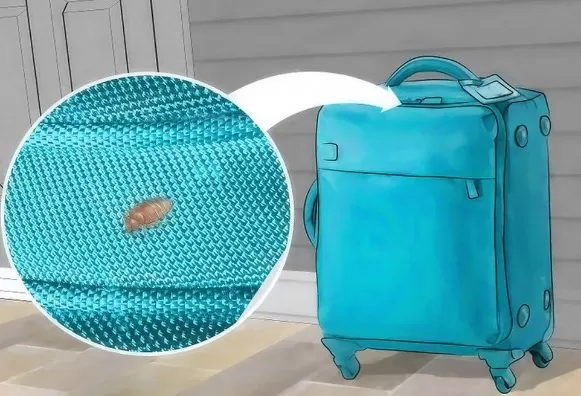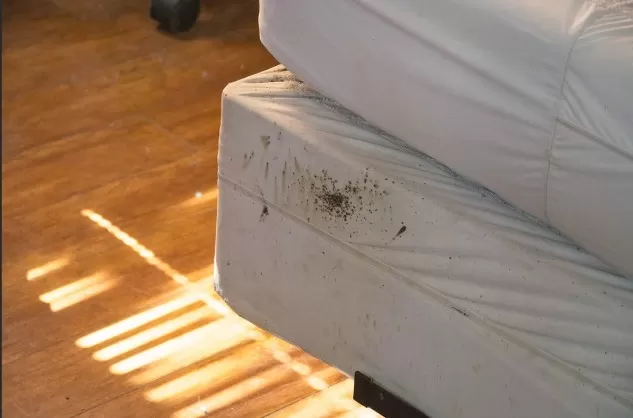Bed Bug Prevention: Essential Tips for Travelers. The anticipation of summer vacation is a joyous feeling, but it’s crucial for travelers to be aware of the potential unwelcome guests that may accompany them: bed bugs.
These tiny, elusive insects can cause significant discomfort with the itchy welts they leave on the skin. To ensure a pleasant and bed bug-free experience, it’s essential to be vigilant and take preventive measures, especially when checking into a hotel.
Bed bugs have a knack for hitching rides, effortlessly transferring from hotels to homes through luggage or clothing. This makes it paramount for travelers to stay on guard and implement precautionary steps. By adopting the following practices, you can minimize the risk of encountering bed bugs during your stay:
Securing Your Belongings: Safeguarding Your Luggage and Prioritizing Bed Bug Checks

As you step into your hotel room, it is essential to prioritize both the protection of your belongings and the examination for any signs of bed bugs.
However, before conducting a thorough inspection, take the necessary precautions to safeguard your luggage by placing it strategically in the bathroom, specifically on the central part of the tiled floor. It is crucial to refrain from setting your suitcases on the bed, as this could inadvertently invite potential bed bug infestations into your belongings.
By following this approach, you proactively mitigate the risk of inadvertently introducing bed bugs into your luggage.
Placing your bags on the bathroom floor serves as a preventive measure, minimizing the chances of these pesky insects hitchhiking a ride on your belongings. It provides a temporary and secure location where your luggage remains unaffected by potential bed bug activity, granting you peace of mind during your stay.
After ensuring the safety of your belongings, it is time to proceed with inspecting the room for bed bugs.
Begin by thoroughly examining the mattress, box spring, headboard, and other furniture pieces in close proximity to the bed. Look out for any telltale signs such as small bloodstains, dark spots (indicating bed bug excrement), shed skins, or even live bugs.
Pay attention to cracks, crevices, and seams, as these are common hiding spots for these unwelcome intruders.
Expanding your inspection beyond the bed area, scrutinize the curtains, upholstery, and carpeting, as bed bugs can often find refuge in these areas.
Use a flashlight to thoroughly examine the corners, seams, and folds of these surfaces, ensuring a comprehensive assessment.
In case you do discover any signs of bed bugs or suspect their presence, promptly notify the hotel staff, requesting a room change or appropriate remedial actions.
Remember to keep your luggage elevated and away from potential infested areas while awaiting assistance.
By diligently following these guidelines, you can minimize the risk of bed bugs infiltrating your belongings and enjoy a worry-free stay, knowing that you have taken necessary precautions to protect yourself and your luggage from these unwanted pests.
Thoroughly Inspect the Mattress: Ensuring a Comfortable and Bed Bug-Free Sleep
Prior to settling down for a restful night’s sleep, it is crucial to conduct a comprehensive examination of the mattress to ensure both your comfort and safety.
By pulling back the bed sheets and inspecting the mattress seams and box spring, particularly focusing on the corners, you can quickly identify any signs of bed bug activity. Look out specifically for rust-colored stains or spots, as they often serve as unmistakable indicators of a potential bed bug infestation. .
By taking this proactive measure, you significantly reduce the risk of encountering bed bugs during your stay.
Identifying any suspicious marks or stains on the mattress allows you to promptly alert the hotel management, enabling them to address the issue and provide you with alternative accommodation if necessary. It is vital to prioritize your well-being and swiftly change rooms or even hotels should you come across any concerning signs.
Remember that this preliminary check of the mattress acts as an initial line of defense against bed bugs, safeguarding your sleep experience and preventing potential bites or discomfort.
By promptly addressing any concerns, you can ensure a comfortable and worry-free stay, free from the unwanted presence of these pests.
In addition to inspecting the mattress, it is also recommended to extend your assessment to other areas of the room.
Check the surrounding furniture, such as the headboard and nightstands, as well as the carpeting and curtains, as these can also serve as hiding spots for bed bugs. Vigilance throughout your entire living space enhances your ability to detect any signs of infestation and take appropriate action accordingly.
By prioritizing the inspection of the mattress and maintaining a vigilant approach to your surroundings, you can rest easy, knowing that you have taken the necessary precautions to ensure a peaceful and bed bug-free sleep environment.
Go Beyond the Mattress: Thoroughly Examine Hidden Areas for Bed Bug Infestation

While inspecting the mattress is essential, it’s crucial to remember that bed bugs can hide in various other locations within your hotel room.
These resilient pests can seek refuge behind baseboards, wallpaper, picture frames, and even furniture, including upholstered headboards, sofas, and wooden pieces. To thoroughly assess these hidden areas, having a pocket-sized flashlight on hand will prove invaluable.
Follow these steps for a comprehensive visual inspection:.
Baseboards and Wallpaper: Illuminate the areas where the baseboards meet the walls and carefully examine them for any signs of bed bug activity.
Similarly, inspect the edges of the wallpaper, paying close attention to any cracks or crevices where these pests might be hiding.
Picture Frames: Direct your flashlight toward the back of picture frames, particularly focusing on the corners and joints.
Bed bugs can squeeze into tight spaces, so be diligent in your inspection to ensure no infestation is present.
Furniture: Give upholstered headboards, sofas, and other upholstered furniture a thorough examination.
Use the flashlight to peer into crevices, seams, and tufts, as these areas provide ideal hiding spots for bed bugs. For wooden furniture, carefully inspect the joints, corners, and any cracks or crevices where bed bugs could potentially take shelter.
By extending your inspection to these often-overlooked areas, you enhance your ability to detect any signs of bed bugs, ensuring a proactive approach to your well-being.
If you happen to spot any pests during your examination, it is crucial to take immediate action. Notify the hotel management promptly, and request a room change or consider changing hotels to mitigate the risk of bed bug infestation affecting your stay.
Remember, an extensive inspection that includes checking behind furniture, along with other hidden areas, provides you with a comprehensive understanding of the room’s condition and empowers you to make informed decisions regarding your accommodation.
By remaining vigilant and proactive, you can safeguard yourself against any potential bed bug encounters, ensuring a pleasant and pest-free experience throughout your stay.
Relocate Wisely: Considerations When Changing Rooms to Avoid Bed Bug Spread
In the event that you need to change rooms due to a suspected bed bug infestation, it is essential to exercise caution and follow specific guidelines to prevent the spread of these pests.
Consider the following points when selecting your new room:.
Distance from Suspected Infestation: Ensure that your new room is not adjacent to, directly above, or below the room with the suspected bed bug infestation.
Bed bugs have the ability to travel through various means, such as housekeeping carts or even through wall sockets. By selecting a room that is at a safe distance from the potential source, you minimize the risk of bed bugs migrating to your new location.
\Spread Patterns: It is important to note that if an infestation is expanding, it usually does so in rooms closest to its origin.
Therefore, selecting a room that is farther away from the suspected infestation reduces the likelihood of encountering bed bugs.
By adhering to these precautions, you can significantly lower the chances of inadvertently transporting bed bugs to your new room and mitigate the risk of a potential infestation affecting your stay.
Additionally, promptly informing the hotel staff about your concerns and your decision to change rooms will allow them to take appropriate measures to address the issue effectively.
Remember, your well-being and comfort are paramount.
By being mindful of the potential for bed bug spread and taking the necessary steps to avoid it, you can enjoy a worry-free and peaceful stay in a room free from these unwelcome pests.
Protective Measures for Your Suitcase: Shielding Against Bed Bug Infestation

To further safeguard your belongings from potential bed bug infestations, it is advisable to take extra precautions by covering your suitcase during your stay at the hotel.
Consider the following steps to minimize the risk of bed bugs taking up residence in your luggage:.
Plastic Bag Enclosure: Utilize a large plastic trash bag or a specially designed protective cover to enclose your suitcase.
Before placing your luggage inside, ensure that it is securely sealed to prevent any potential bed bugs from entering. This additional layer acts as a deterrent, making it more challenging for bed bugs to access and infest your belongings.
Vigilant Disposal: When you return home, it is crucial to dispose of the plastic bags or protective covers used to enclose your suitcase.
Do this before bringing your belongings inside your home. Discarding the bags outside of your residence reduces the possibility of any bed bugs that may have been trapped within from spreading to your living space.
By implementing these measures, you create an added barrier against bed bugs, reducing the likelihood of them hitchhiking a ride in your suitcase.
These preventive steps provide peace of mind, allowing you to enjoy your travels without the concern of inadvertently bringing bed bugs back home with you.
Remember, maintaining vigilance and taking proactive measures to protect your belongings from bed bugs enhances your overall travel experience and ensures a smooth transition upon returning home.
*The information is for reference only.